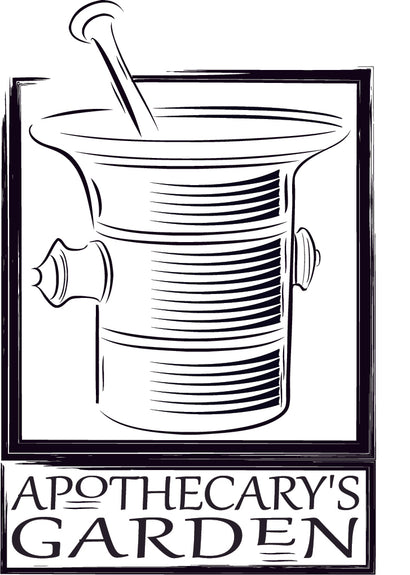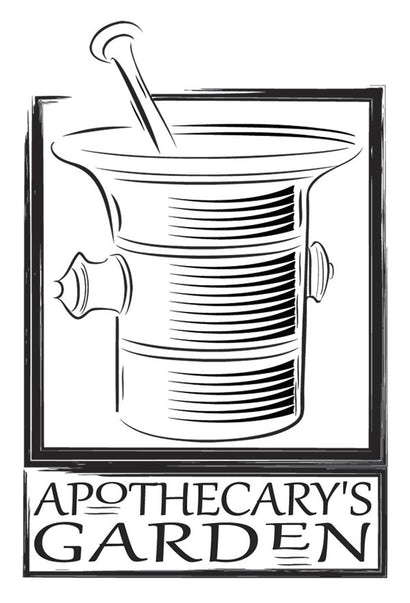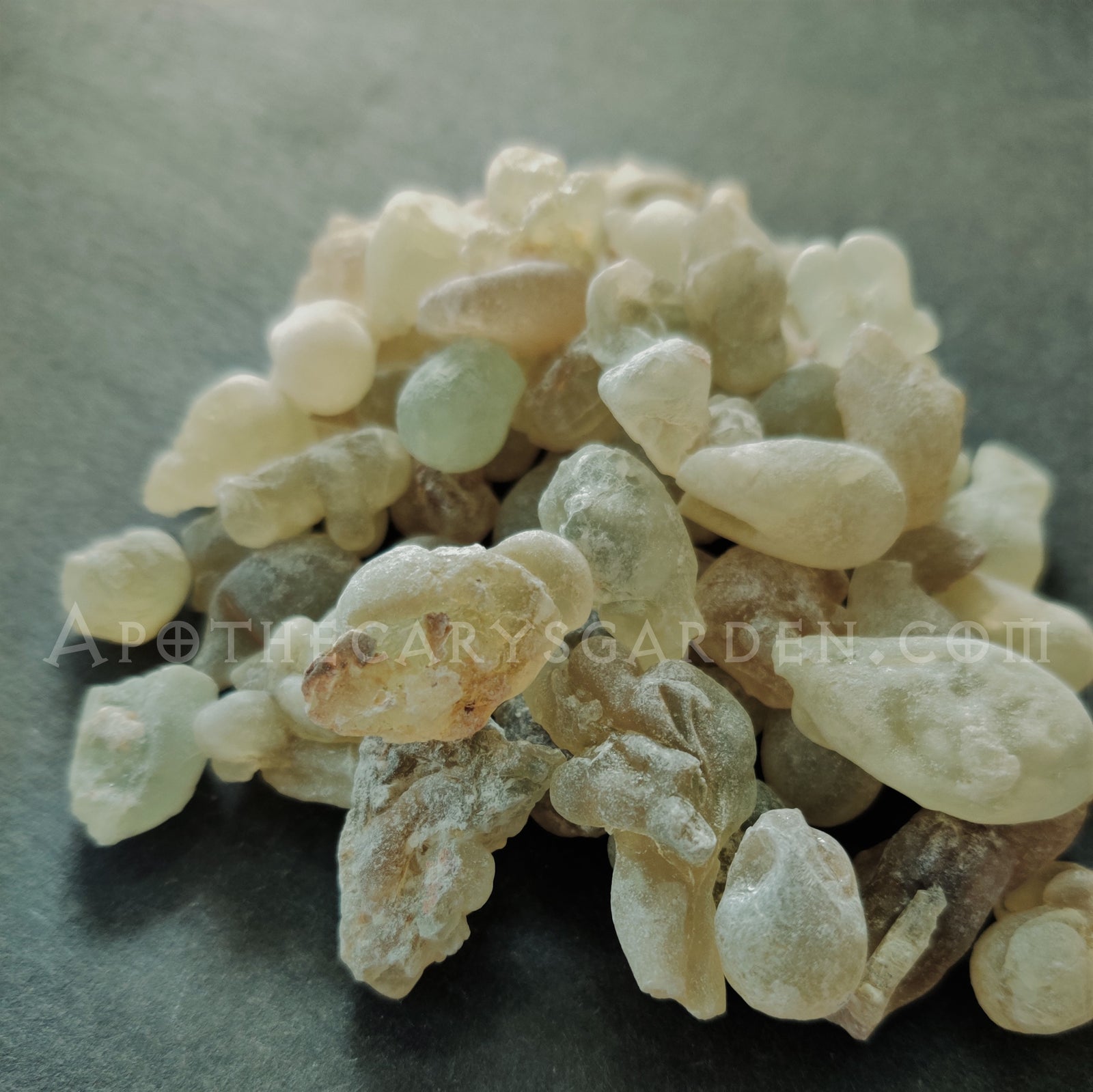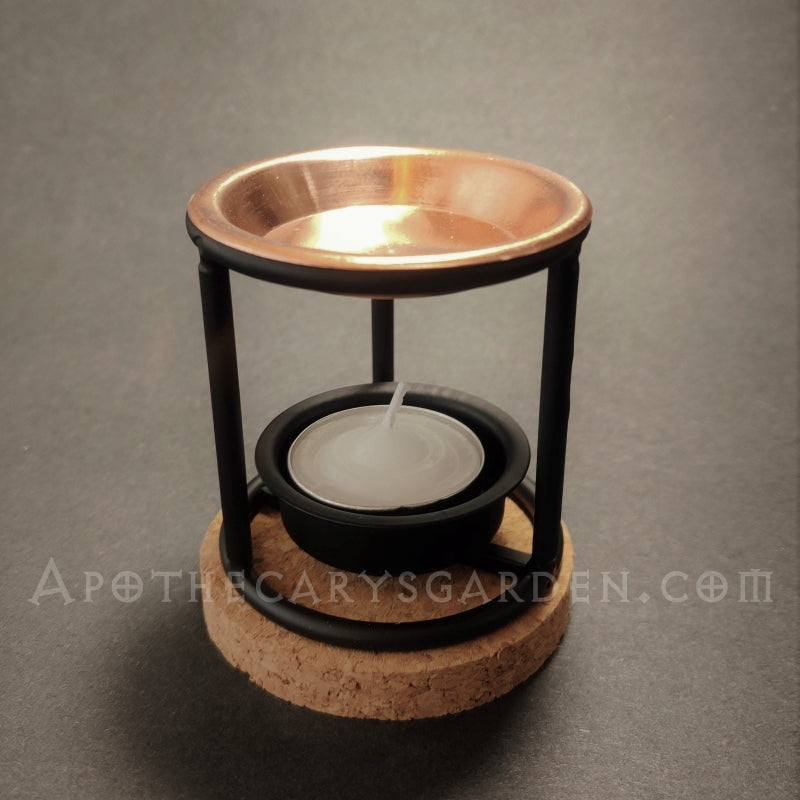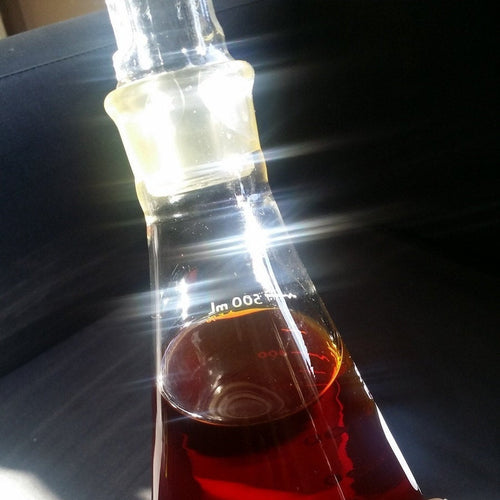I get a lot of questions about Frankincense and other aromatic materials in the shop. Especially ubiquitous is the question, how do I burn this? A relatively small bit of information that can open up a glorious world of olfactory exploration, enrichment and appreciation.
So, without further ado, let me tell you what you need to know.
How do I burn Frankincense, Myrrh and other Resins?

Myrrh tree in the wild of Ethiopia. Photo courtesy professor Ermias Dagne
Raw incense resins are usually aromatic exudates formed on the surface of trees and plants. Most are used as medicine, perfume and incense, as well as for many other applications such as adhesives, lacquers and varnishes. We have used them since time immemorial, across the globe, and in every culture.
Oleoresins and Oleo-gum-resins
Though we like to call them saps, they differ from the true sap of the tree since they are usually produced by special ducts close to the surface of the tree in response to injury and are not part of the system that conveys nutrients. The purpose of these aromatic exudates is to repel insects, disinfect wounds and provide a barrier between the wound and infectious organisms.
They are named oleoresins since they contain oil, (Volatile or essential oil), and resin acids or resin. Many, such as most types of Frankincense, also contain water-soluble gum which makes them Oleo gum resins. Now that we have our terminology straight, let's see what we can do with them.

Fresh tapped Frankincense Carterii. Ufeyn area Somalia. Credit M. Nur Warsami
Plant Resins burned as Incense
As incense, these oleoresins are burned, alone or in combination with other fragrant materials such as powdered bark, flowers and essential oils. In many cultures, hot embers from the oven or cooking fire are used to burn incense resins. Most Western cultures use manufactured pucks made from compressed powdered charcoal. In countries where burning oleoresins is a daily tradition, one will find simple and ornate electric burners in most homes.

A selection of some of the Frankincense types you will find in the shop
Churches and temples of many religions practice some form of ceremonial burning of incense, whether as an offering to the God, Goddess or Gods, to connect with ancestors, to purify the space, or to create a receptive atmosphere for supplicants. Studies have shown that oleoresins such as Frankincense contain psychoactive ingredients that affect our brain chemistry through their smoke.
Incense for purification and healing
Incense is burned in many countries daily before meditating and after cooking to purify and cleanse the home physically and energetically for magic, ritual, and healing. In some cultures incense has been a vehicle of healing and part of traditional medicine. It has been shown that our bodies can absorb the medicinal, healing properties of oleoresins such as Frankincense through the smoke released while burning. For instance, Incensole and Incensole acetate are two such chemical compounds found in Frankincense Papyrifera that can induce feelings of heightened spirituality and well-being, and reduce feelings of depression and anxiety.
Each country, culture, and often different provinces or villages have unique recipes for their traditional incense type or blend.

Methods of burning Frankincense and other resins
The most common method of burning resins as incense is by placing a small, pea-sized chunk on a piece of smouldering charcoal. The heated oleoresin melts and burns, releasing its essential oils first (the oleo part). The resins which require a higher temperature follow suit, producing aromatic smoke with a fragrance unique to each oleoresin.
Today, in most Western cities, we can find foil-wrapped charcoal pucks in corner stores, head shops, and Asian and Mediterranean food stores often wherever Hookahs and Nargilehs are sold.
A variety of charcoal pucks can be found in the shop here
Various odoriferous natural materials such as tree and plant oleoresins, powdered fragrant woods and barks, flowers and essential oils are common ingredients in traditional and modern incense products.
Many types of incense are available commercially, pre-mixed and pre-formed as cones, discs, sticks, ropes, papers and powders. Often, their base material is finely ground Sandalwood powder; some types use natural gums as an adhesive to hold their shape, and some contain combustibles such as Joss powder and or charcoal powder to keep them burning consistently.
Synthetic compounds and Artificial aromas
Unfortunately, to lower production costs and increase profit margins, synthetic fragrances and colours are often used instead of natural materials.
Most of the cheaper “dollar store” varieties of cone and stick incense fall into this category. Knowing this makes using whole oleoresins and natural fragrant materials even more appealing. One can burn small amounts of a single oleoresin, such as Frankincense, Myrrh or Mastic, or compound a unique incense creation by powdering and blending ingredients. It is an easy and very gratifying process that requires no great skill, financial outlay or expensive tools.
A simple way to experiment with incense making and enhance your enjoyment of resin incense, is by adding a drop or two of your favourite essential oils to the resin, while or before burning. For easy instructions on making your own incense from Frankincense, Myrrh, Pine or Spruce and many other fragrant oleoresins, please see my post-Instructions for making Natural Incense-Powders, Pastilles and Cones.
Using a censer to burn incense
After you have some charcoal, you will need something to burn your incense in. A censer.
Censers can be purchased made from different materials and in many styles. They can be found in brass, silver, steel or ceramic, from the simplest of designs to the most elaborate and bejewelled, open to the air, or with ventilated lids. Practically any non-flammable container, dish or bowl found in the average home can be used as a censer. A fully functional censer can be as simple as a glass or ceramic plate or bowl layered with an inch of unscented kitty litter, fine gravel or sand. This non-flammable, insulating layer keeps the hot coal from heating the censer and burning fingers, tables, and anything else it comes in contact with.
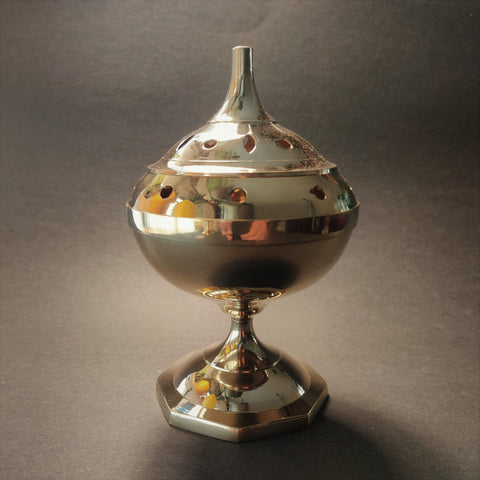
How to burn Frankincense resin on a charcoal puck
Light an edge of the puck with a lighter. (Hold it on the opposite side!). When it starts to sparkle a bit, or make a slight crackling, hissing sound, then the Saltpeter has been activated and the coal is igniting. (Some people do this outdoors to avoid the unpleasant aroma of the Saltpeter.)
Place your coal on the sand or litter and wait till there is a fine layer of white ash covering the puck.
Less is more
Take a small piece of Frankincense or some other incense resin, ( the size of a small pea or a lentil), and place it in the middle of the coal. It will shortly release its fragrance and smoke, and there you have it. Pure, natural incense. Be advised however, that less is better than more in this case since too much oleoresin can flood and extinguish your puck.
Never leave lit charcoal unattended, or close to flammable materials, curtains, kids or cats.
Low-odor charcoal pucks
There are alternatives to the Saltpeter infused “quick starting” charcoal discs. Several charcoal products on the market contain no Saltpetre. One can also find cubes and sticks of compressed charcoal made from coconut shells, bamboo and other sustainable materials. The only drawback to these more natural charcoal alternatives is that they can be very challenging to light.
Tea Light Burners
Tea Light Burners or heaters are a relatively new product on the market. Rather than burning the aromatic materials at a high temperature and releasing clouds of smoke, they release the aroma of the material with little to no smoke. This suits many people who live with others, are sensitive to smoke, or simply want to enjoy the subtler nuances of aromatic materials, not through a smoke bomb. Smoke definitely has its place, especially when cleansing a space or perfuming one's clothes. Still, there is a lot to be said about "listening" to the materials as they slowly reveal the layers and facets of their character to us. And though electric burners have similar advantages, the price of a tealight burner makes it accessible to more of us.
Here are some tricks you need to know about using tealight burners.
- Resins containing water-soluble gum, such as most Frankincense and Myrrh resins, must be crushed before placing them in the burner tray.
- A square of tinfoil or an aluminum muffin cup placed on the tray will keep the tray clean. Especially when using pure oleoresins that flow with the heat.
- If you want to raise the temperature of your burner, a beeswax tealight candle will do so, as will a coin inserted under the candle.
A stovetop censer
Another method, which is halfway to an electric incense burner, is the use of a piece of tin foil, or thin metal baking tin and the electric element on your stove. One can place an appropriate, thin, heat conductive and non-flammable metal sheet on the element, place a piece of resin or some powdered incense on it, and wait for it to smoulder. It is advisable to start at a very low temperature and work one's way up to higher settings. Heat can be adjusted as needed on the stovetop. Keep in mind that aluminum foil will melt or burn if the heat is too high. Remember, this will become VERY hot, so plan exactly how you will maneuver it on the stove. (One can purchase tongs and spoons especially for working with incense.) Thin pieces of Mica can also serve the same purpose and can be cleaned with alcohol and reused indefinitely.
Using an electric incense burner
Though using the aforementioned charcoal pucks to burn our incense is the most common method one sees nowadays to enjoy raw incense resins and natural incense blends, it does have some drawbacks.
Charcoal pucks burn at a high temperature. Incense resins disappear quickly in a cloud of smoke and one misses many of the aromatic nuances they offer us. This is especially the case with the exotic woods. The temperature of the charcoals also burns the gum portion of Frankincense, Myrrh and other oleoresins which smells charred. Most all Frankincense types and Myrrh types are in reality, Oleo-Gum-Resins. They all contain between 20% and 60% water-soluble gum that does not melt, has no fragrance on its own, and does not smell very nice when burned. That's just life. The ancient Egyptians used the leftover charred gum in the preparation of Kohl. The traditional Egyptian eyeliner which is still used in many cultures.
- When we heat Frankincense or Myrrh the volatile, or essential oils are first to evaporate and reach our noses, next, the resins reach a temperature where they combust with the heat and generate fragrant smoke. However, once the resin portion has burned, the water soluble gums follow suit. These gums simply create a charred or burnt smell which in general is unpleasant. Usually, this is not too obvious and there is enough fragrant smoke to mask the smell of the burning gums.
- Many precious exotic and fragrant woods like Oud, or Agarwood, and Sandalwood, provide us their fragrant essential oils and resins in a matrix of their wood. Since a charcoal puck burns at a temperature that immediately combusts the wood along with the delicate essential oils and resins we miss out on most of the softer richer and more nuanced facets of the material..
The solution to all the above issues with using charcoal are elegantly resolved by using an electric incense burner. A heater really. An electric burner allows us to regulate the burning temperature according to the material we are using and to make the most of each fragrant material. An electric incense burner also allows us to greatly extend the time each incense give us for its enjoyment, sometimes by hours. We can enjoy a completely smoke-free experience if we so choose by keeping the temperature low enough to only release the fragrant molecules into the atmosphere with no actual combustion. An electric burner also allows us to use only some of the incense and save the rest for later. All in all, it offers us much more control and room for enjoying the experience than charcoal pucks.
You can find good-quality electric incense heaters HERE in the shop
Making incense from local oleoresins and other natural aromatic materials
No matter where you live, there are natural fragrant materials perfectly suited for use as incense, (and perfume), found in nature all around you. Pine, Spruce and Fir trees all have wonderfully fragrant oleoresins, wood and needles. Cedar leaves, White sage, and tobacco are ingredients in Native American Smudge or incense mixes. If you collect from the wild, Always be respectful of plants and the land. This is very important!! I can’t stress this point enough here.

Always give before taking
Always give to plants and to the land before you take anything. Thus you can establish and nurture a mutually respectful and reciprocated relationship. The best kind to have with anyone. Plants will give to you as generously as you give to them. It is up to us to set the tone for our relationships. Plants rarely place limits on them. This is how one opens the door to communicating with plants and tapping in to ancient knowledge.
Collect some Pine, Fir or Spruce sap, without damaging the tree, preferably after you have given the tree something, a symbolic gesture is fine, whether a few supportive words, an acknowledgement of your gratitude for their gifts, leave something personal or something that has meaning to you. Sometimes our Pine trees exude their sap due to an injury caused by the larva of a borer beetle. If you come across a single one eighth of an inch hole under the sap you have scraped off, a stiff piece of metal wire poked deep into the hole will put an end to the creature who has damaged your tree, and will make sure it does no further harm.
Though one person smushing the occasional grub will have absolutely no effect on the blight of borers decimating our forests, it is a clear and practical act of caring and giving , an act of stewardship. For this reason I always carry a wire with me. We each find our own ways of developing and nurturing our relationships with trees, plants and nature.
I beleive there is one single problem with our civilization as a whole that underlies many of the diseases and socio-economic problems we face : how divorced and separated we have all become from nature and how poorly we treat it in our rush to capitalize on every resource we can profit from. We take and do not give anything in return. Put simply, our concept of profit is making sure we take more than we give. Someone always loses and someone always wins. Nature is always on the losing end of commerce.
If you want to change the world, always give more than you take.
These local oleoresins are lovely burned as incense. For easy cleanup of hands, tools and containers from the sticky oleoresin, use a little olive oil or vegetable oil followed by warm water and soap. The oil and resins will leave your hands feeling soft and supple. There are many valuable healing Phytochemicals in these oleoresins whose main function is to protect and heal the “skin” of the tree.
Storing aromatic materials
Most aromatic materials will keep well in the pouches and tins we provide in the shop for at least a year. It is important to keep them in a relatively cool place and out of direct sunlight. For long-term storage, I suggest transferring them to a sealed glass container. many resins will keep thus for decades.
If you decide to pursue the art of incense making and create your own incense blends and products there is an excellent online incense making course run by the Northwest school of Aromatic medicine.
So, enjoy the bounty of nature, try to give more than you receive.
And remember, always take clear notes! Your future self will thank you!!
Dan

Dan Riegler is an Herbal Apothecary, Artisan, formulator, distiller and advocate for sustainable management of our aromatic and medicinal plants. A lover of Nature, he is a friend to trees and a sap for resins. Apothecary's Garden provides an ever-growing selection of fresh & fair trade, ethical and sustainably harvested medicinal and aromatics including Frankincense and Myrrh, local and exotic fragrance materials, artisan distilled essential oils, natural perfume ingredients and animal essences. Apothecary's Garden shop also showcases Dan's aromatic, cosmetic and therapeutic preparations, salves, cremes, tinctures and oils, as well as those of Guest artisans from around the world.
The Blog, Apothecary's Garden is a journal about Herbs, plants and processes, recipes, plant Alchemy, traditional wisdom and our Relationship with Nature.
